https://kidswritetoread.com/wp-content/uploads/2020/03/CHANGE-AGENTS-GROUP-3-PUB-1.pdfDefinition of Terms
The confusion and controversy over phonics seems endless, and this issue is vitally important, so let’s take a careful look at it. First, I’ll define the terms as I’m using them:
- “Phonics” refers to the sound-symbol relationships, i.e., how the sounds uttered in English can be spelled.
- “Phonemic awareness activities” draw the children’s attention to and help them recognize the sounds we speak by having them play with isolated sounds through chants, songs, and other activities.
The question is not whether children should learn phonics, but how and when
Of course children need to come to know the sound-symbol relationships if they are to spell words others can recognize, as well as sound out unfamiliar words as they read.
So the issue is not whether children learn phonics, it’s how and when we help them do it. And I have found it is not necessary, or even advisable, to “teach phonics” for children to gain that skill, any more than it was necessary to “teach speaking” for them to learn to speak.
For as with everything else — children learn best BY DOING. They absorb the connection between letters and sounds — BY USING phonics materials for spelling — as they write their own thoughts.
Therefore, their time is much better spent on writing that includes a strong phonics component — rather than on memorizing the sound-symbol relationships in isolation.
How many of you have seen children get 100% on a spelling test, only to turn right around and misspell some of the same words while writing? (Very few skills are best practiced, learned, and tested in isolation — with some math skills being a notable exception.)
~
Absorbing Phonics Through Use While Writing
Develops Two Valuable Skills:
Spelling and the Ability to Sound Out Words While Reading
~
Phonics Materials: A Pictorial, Sound System
So, during the time spent translating their own speech into print, children will learn both phonics and how to write — skills that readily transfer to reading.
That said, while not absolutely necessary, a sprinkling of group phonemic awareness activities, separate from writing, can also help. Not only will these activities make children more aware of the separate sounds that make up words, but the phonics materials used for these activities can later become a valuable resource for spelling.
Pictures with stories are easy for children to remember. So at the heart of my approach was a set of Phonics Cartoons which evoked stories that piqued the children’s interest.
Most of the cartoons I used were tracings I made of pictures I found in children’t coloring books. And I drew a few myself.
I added the most common way to spell the sound pictured in each cartoon. Then I copied them on 9’X 12″ card stock and had some older children color them for me. These were used in a total group setting on the rug — for phonemic awareness.

I use mine as examples here, but cannot make them available to others — because I traced my cartoons from coloring books. So the originals are no doubt still under copyright.
So I’m using them here to illustrate how to incorporate phonics into writing. But I have found what looks like a very good, but inexpensive, set of phonics charts on Amazon, made by Jolly Phonics.
The Jolly Phonics charts are a set of 42 pictures. Each picture evokes the sounds (not letter names) and shows the most common letter(s) making that sound. The one pictured here is the story of a snake making the Ssssss sound. (Ignore the fact that it’s a snake, instead, focus on the sound the snake is making: Sssss).
You could have such a set enlarged or shrink them to use in the various ways I describe below.
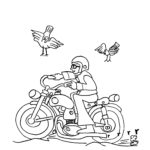 So using my cartoons just as an example here: I introduced them with a simple story I thought would resonate with my children. For example, the motorcycle is making an
So using my cartoons just as an example here: I introduced them with a simple story I thought would resonate with my children. For example, the motorcycle is making an 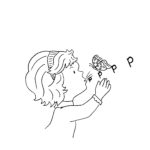 “rrrr” sound as it roars. The girl is trying to blow the butterfly away without hurting it. So she makes a very soft “p p p p” sound.
“rrrr” sound as it roars. The girl is trying to blow the butterfly away without hurting it. So she makes a very soft “p p p p” sound.
The “Long A” sound is made by the fans in the bleachers trying to unnerve the batter by chanting, “A batter, A batter, A batter,” which was a common chant in our area during softball games. The “Short A” sound is the boy crying because he 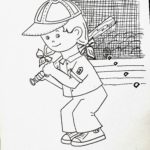 skinned his knee. These stories seemed to “stick,” after just one time of telling and
skinned his knee. These stories seemed to “stick,” after just one time of telling and 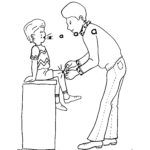 playing with them.
playing with them.
I began introducing them at the beginning of the school year — only one new sound a day, while also reviewing all cartoons previously introduced. So by the second month of school most of the children knew them all. (I did NOT mention the letter that was on the chart.)
From then on, the older children, who were beginning to write independently, used them as a resource for spelling.
A tw0-Stage Process for incorporating phonics into writing
Using the cartoon sound system, I took my students through a two-stage process. First, they linked a sound to a “story” evoked by a cartoon and played with the sound.
No mention of the letter needed was made at this stage. Then while writing, when they needed to spell a particular sound, they recalled the cartoon and story that went with that sound — then went to see what letter(s) were written on that cartoon.
Here’s how this two-stage process went:
Stage 1. Use Phonemic Awareness Activities That Link the Cartoon to a Story That Evokes a Sound, and Then Play With the Sound:
I introduced the cartoons, only one a day, referring to them as “Today’s Sound,” beginning with consonants, then vowels, and finally, digraphs. While I told a very brief story suggested by the picture, I did NOT mention the letter that appeared on the cartoon. (Before introducing each day’s new sound, we reviewed previous sounds by showing the cartoons in quick succession while the group of children called out the sound.)
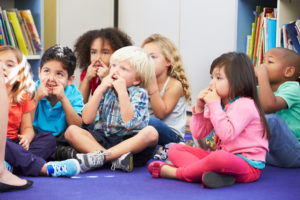 Then we played with the sound in a variety of ways:
Then we played with the sound in a variety of ways:
- feel the sound, as children in the image are feeling how the “nnnnn” sound vibrates their nose,
- identify whose name begins with that sound,
- listen as each child substitutes Today’s Sound for the beginning sound of their name,
- identify one of their own physical attributes or an article of clothing that begins with Today’s Sound, and/or watch as someone goes to find two things in the room that start with the sound.
Immediately following this play, we would place the cartoon in a place of honor and refer to it during the day, as well as just before dismissal.
Stage 2. Use the Phonics Cartoons For Spelling One Sound While Dictating Key Words and Sentences
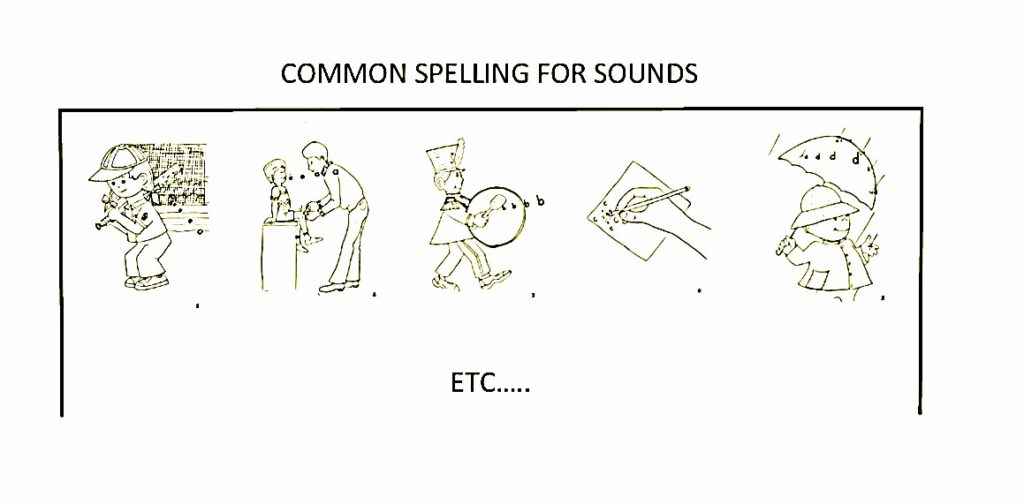 Beginners Use the Cartoons in a Simple Chart.
Beginners Use the Cartoons in a Simple Chart.
Once the stories for all the cartoons had been introduced, I made a reduced version of the large cartoons, small enough to fit all of them together on a chart for the wall. In Steps 2 – 4, children used that chart to identify which letter they needed to help spell the one new sound they were to help supply for their Key Word that day.
When they reached a sound they didn’t know how to spell, the person taking their dictation (the helper) would ask whether they remembered which picture made that sound. If the child did not remember, they would remind them of the story. Then the child would leave the table, find the picture that evoked the sound needed, note the letter, and return to the helper. Before they would write it, the child first had to form the letter, with their finger on the table. If the child had forgotten, they had to go back and look again. With having to keep in mind the sound and letter together that long, they would usually remember it the next time they needed it. (Notice that the child only had to supply ONE new sound each day.)
More Advanced Writers Use the Cartoons Made Into a Wall Strip Dictionary
 Our Wall Strip Dictionary charts were an extremely valuable tool for spelling, the mainstay of our spelling program, instead of spelling books or spelling tests. Children at Steps 5 and 6 used them when they needed to know how to spell an entire word. The were 38 of them, hanging from cup hooks on the wall in alphabetical order, each with a different cartoon heading it. When a child needed to spell a word, they would find the cartoon for the beginning sound of the word they needed help spelling.
Our Wall Strip Dictionary charts were an extremely valuable tool for spelling, the mainstay of our spelling program, instead of spelling books or spelling tests. Children at Steps 5 and 6 used them when they needed to know how to spell an entire word. The were 38 of them, hanging from cup hooks on the wall in alphabetical order, each with a different cartoon heading it. When a child needed to spell a word, they would find the cartoon for the beginning sound of the word they needed help spelling.
First, they would look to see whether the word they needed was already written on the strip (because someone else had previously asked to have it written there). If yes, they would take it to a table and copy it. Then — remarkable as it sounds when I think back on it now — they would always immediately hang it back up again. (I can’t recall a time when a strip was left out somewhere on a table. This was no doubt due to the fact that they had all practiced returning it during the Silent Demonstration used to introduce it to each child. More about the rather amazing power of Silent Demonstrations in Preparing For the Active Work Period.)
If the child did not find the word there, they would take it to a helper. First that person would check to see if the word actually was not there, and if it was, help the child look for it again by covering the words below and above it — leaving 4 or 5 words showing for the child to choose from. If not, then the child would help supply the sounds needed, as the older person wrote the correct spelling. (Children were not allowed to write on the strips.) The image of the Wall Strip Dictionary shown here has the three ways to spell the “s” sound. In our classroom, after it had been used, the strip would also have written on it, such words as, for example, soap, Superman, city, cyclone, etc. This would depend on what words children had previously requested. I did not start the strips out with words the children had not asked for while writing. We had a separate chart of Frequently Used Words for that purpose. (See bottom of this page.)
I tried giving the advanced writers an individual dictionary with all the cartoons in it — one cartoon per page, in alphabetical order. But they much preferred the class Wall Strip Dictionary to the individual one, so that saved me the trouble of making them. This also meant any given word only had to be written one time for the entire class, which saved time during our busy writing period, too. For my K-2 classroom, I removed the words from the strips before each new school year, by cutting off and replacing the bottom part of the strip. The older children from the year before already knew how to spell many of the words on the strips, and I wanted the younger ones to have to help sound out and spell a fairly high percentage of the time. (The strips were approximately 3 inches wide and the length of large chart paper.)
Additional sources for spelling: class generated charts and a Chart of Frequently Used Words
The walls were lined with charts as resources for spelling: a few of our latest Today’s News, songs, chants, and lists of Special Words children had brainstormed during a total class activity. We also had charts posted of words frequently used by children of primary age, which included service words.* The children were to check first in the places they thought a word might be, before coming for help. This included not only the charts on the wall, but the word cards and sentences on their own Word Ring or that of a friend, as these had always been written by someone older who could spell correctly.
Brainstorming Special Words: This was a very valuable total group activity. The children sat on the rug while I quickly wrote on the chalk board the words they called out to me. The topic would be any special occasion: seasons, special events or interests, holidays, etc. I only did this when I had two helpers with us to act as recorders. I gave each recorder a stack of sturdy word cards and a large felt-tipped pen. They would record the words I was very quickly writing on the chalk board — alternating words, so they would each have time to make a neat copy.
When we had finished brainstorming a few dozen words, I would tape four or five strips of masking tape — sticky side out — onto the blackboard. Each strip would have a heading for one category. For example, if the topic was Christmas, I might write strip-title cards for five categories: WHAT I WANT – WHO WILL VISIT – DECORATIONS, – FOOD – FUN ACTIVITIES, placing one at the top of each of the strips. Picking up the stack of word cards my helpers had made, I would read each card out, and the children would tell me under which category I should place that word. (I tried this once with NOUNS, ADJECTIVES and VERBS, just to see what would happen, and it went surprisingly well.) I would later place the strips on the wall, under the heading, CHRISTMAS WORDS. These brainstormed words gave the children ideas for stories, and they used them often.
_____________
*Chart of Frequently Used Words:Click here for a PDF version of a list I had a parent volunteer copy onto chart paper to post on the wall. You can find other lists online, but some are not alphabetized, and I suggest you use one that is alphabetized, as it’s easier for the children to search for the word they need.
next —> Moving into books